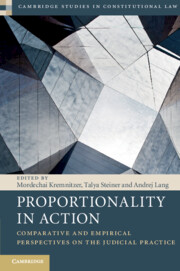Book contents
- Proportionality in Action
- Cambridge Studies in Constitutional Law
- Proportionality in Action
- Copyright page
- Contents
- Figures
- Tables
- Contributors
- Preface
- Cases
- Introduction
- 1 Proportionality Analysis by the German Federal Constitutional Court
- 2 Proportionality Analysis by the Canadian Supreme Court
- 3 Proportionality Analysis by the South African Constitutional Court
- 4 Proportionality Analysis by the Israeli Supreme Court
- 5 Proportionality Analysis by the Polish Constitutional Tribunal
- 6 Limitation Analysis by the Indian Supreme Court
- 7 Comparative and Empirical Insights into Judicial Practice
- Index
3 - Proportionality Analysis by the South African Constitutional Court
Published online by Cambridge University Press: 14 April 2020
- Proportionality in Action
- Cambridge Studies in Constitutional Law
- Proportionality in Action
- Copyright page
- Contents
- Figures
- Tables
- Contributors
- Preface
- Cases
- Introduction
- 1 Proportionality Analysis by the German Federal Constitutional Court
- 2 Proportionality Analysis by the Canadian Supreme Court
- 3 Proportionality Analysis by the South African Constitutional Court
- 4 Proportionality Analysis by the Israeli Supreme Court
- 5 Proportionality Analysis by the Polish Constitutional Tribunal
- 6 Limitation Analysis by the Indian Supreme Court
- 7 Comparative and Empirical Insights into Judicial Practice
- Index
Summary
The chapter presents an analysis of the application of the proportionality doctrine in the case law of the South African Constitutional Court. Based on both a qualitative and quantitative analysis of a large sample of case law applying proportionality, the chapter uses quantitative indicators to provide an overview of the characteristics of proportionality analysis in action, including the rights and subject matters to which proportionality is applied, the division of labour between the stages of the analysis when striking down measures, and termination rates for each stage following a failure. The data reveals that although the failure rates at the worthy purpose, suitability, and necessity stages are surprisingly high, the court generally continues its analysis to also consider the balance between values. These findings lead to a nuanced understanding of the South African court’s global application of proportionality, in which the court utilizes all elements of the analysis in each case to evaluate whether allowing a particular limitation or striking it down advances constitutional values more faithfully. The chapter further analyses qualitatively the formulations and applications in practice of each of proportionality's subtests, exposing the range of interpretations given and the content that has been infused into the different stages.
Keywords
- Type
- Chapter
- Information
- Proportionality in ActionComparative and Empirical Perspectives on the Judicial Practice, pp. 193 - 284Publisher: Cambridge University PressPrint publication year: 2020



